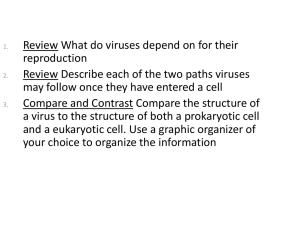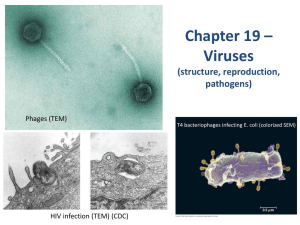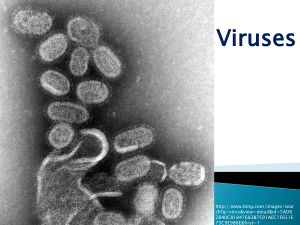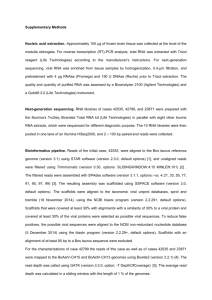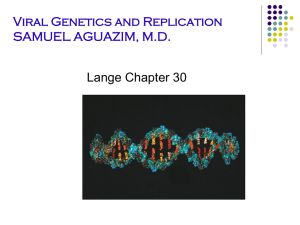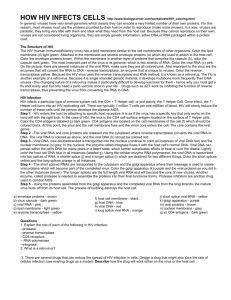Topics 16 Genetics of Virus - 12S7F-note
advertisement
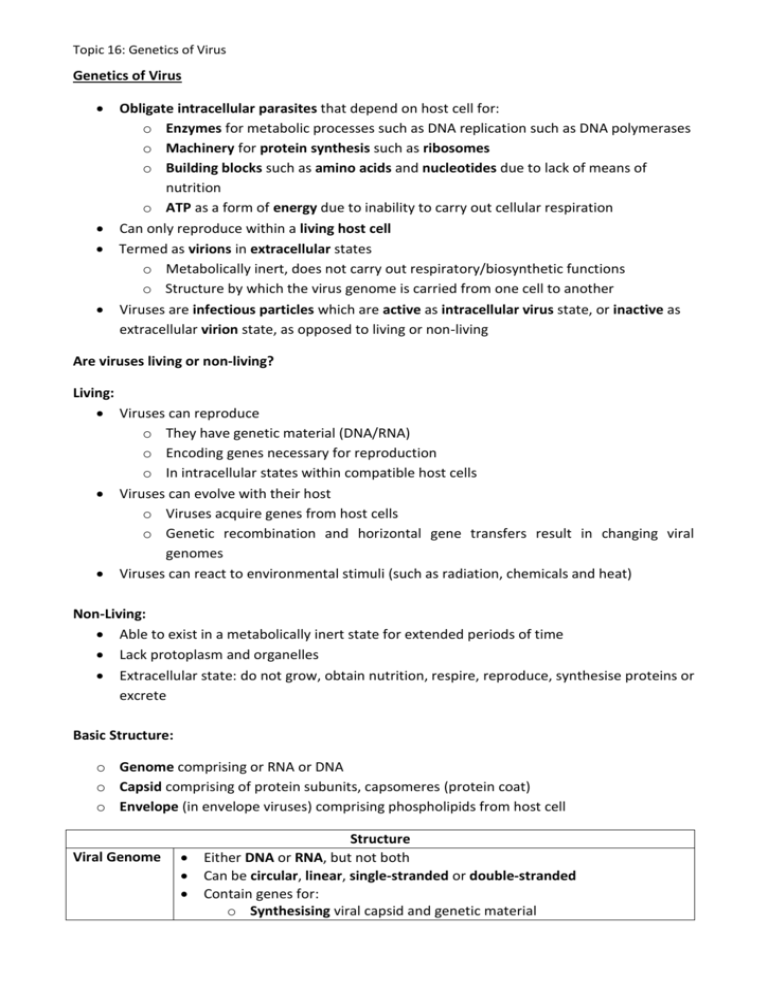
Topic 16: Genetics of Virus Genetics of Virus Obligate intracellular parasites that depend on host cell for: o Enzymes for metabolic processes such as DNA replication such as DNA polymerases o Machinery for protein synthesis such as ribosomes o Building blocks such as amino acids and nucleotides due to lack of means of nutrition o ATP as a form of energy due to inability to carry out cellular respiration Can only reproduce within a living host cell Termed as virions in extracellular states o Metabolically inert, does not carry out respiratory/biosynthetic functions o Structure by which the virus genome is carried from one cell to another Viruses are infectious particles which are active as intracellular virus state, or inactive as extracellular virion state, as opposed to living or non-living Are viruses living or non-living? Living: Viruses can reproduce o They have genetic material (DNA/RNA) o Encoding genes necessary for reproduction o In intracellular states within compatible host cells Viruses can evolve with their host o Viruses acquire genes from host cells o Genetic recombination and horizontal gene transfers result in changing viral genomes Viruses can react to environmental stimuli (such as radiation, chemicals and heat) Non-Living: Able to exist in a metabolically inert state for extended periods of time Lack protoplasm and organelles Extracellular state: do not grow, obtain nutrition, respire, reproduce, synthesise proteins or excrete Basic Structure: o Genome comprising or RNA or DNA o Capsid comprising of protein subunits, capsomeres (protein coat) o Envelope (in envelope viruses) comprising phospholipids from host cell Viral Genome Structure Either DNA or RNA, but not both Can be circular, linear, single-stranded or double-stranded Contain genes for: o Synthesising viral capsid and genetic material Topic 16: Genetics of Virus Envelope (only in envelope viruses) Capsid o Regulating the action of host genes for packaging of mature virus Surrounds the nucleic acid or encloses it Constructed from identical protein subunits called capsomeres Derived from host cell when virus is released by budding Host cell’s surface membrane is incorporated i.e. phospholipid bilayer and glycoproteins of viral origins Protects the virion’s nucleic acid from the effects of various enzymes and chemicals Reproductive Cycle Viruses can only replicate in suitable hose cells i.e. host range. This is obtained by a complementary fit between viral surface glycoproteins and specific receptor molecules on the surface of host cells Comparison of Bacteriophages T4 Lambda phage Structure Long tail consisting of a tail Single tail fibre sheath surrounding a central Multiple tail fibres tube to Multiple tail fibres Base plate Genetic Material Linear, double-stranded DNA Location of capsid Capsomeres surround the nucleic acid, contained in the head of the phage Repro- 1. Multiple tail fibres attach to Single tail fibre attaches to specific ductive Adsorption specific receptor sites on the receptor sites on the surface of Cycle surface of a bacterial host cell bacterial host cell Base plate settles down on Base plate settles down on the host the host cell surface cell surface 2. Conformational changes occur in the tail sheath causing it to contract Penetration DNA is extruded from the head, through the tail (central) tube and injected into the host cell passing through both the cell wall and cell membrane Capsid is left on the outside of the bacterial cell wall 2A. Genome circularizes and inserts itself prophage into prophage insertion site on formation bacterial chromosome by genetic recombination Integrated phage genome is known as a prophage Viral DNA is replicated with host cell DNA each time the cell divides, passing on to generations of daughter cells Produces a large population of bacteria carrying the virus in prophage form Topic 16: Genetics of Virus With an environment trigger, the virus switches from lysogenic cycle to lytic cycle Lysis genes which were repressed during lysogeny are activated, allowing phage genome to exit from bacterial chromosome to give rist to new active phages 3. Synthesis Synthesis of host DNA, RNA and proteins is halted & Host cell machinery is taken over by the virus for nucleic acid synthesis replication Host DNA is degraded into nucleotides, providing raw materials for phage DNA replication Phage mRNAs are synthesised by host RNA polymerase via transcription Phage mRNAs are translated by host cell ribosomes, tRNAs and translation factors into viral proteins and enzymes required to rake over host cell and replicate phage nucleix acids These include enzymes for viral replication and inhibitory factors that stop host cell RNA and protein synthesis 4. Assembly 3 separate sets of viral proteins are assembled to form phage heads, tails and tail fibres each Different components are assembled into the complete bacteriophages 5. Release Phages lyse the host cell by the action of the enzyme lysozyme, which digests the bacterial cell wall Water enters by osmosis, causing the cell to swell and burst Comparison of Enveloped Animal Viruses 2B. spontaneous induction Structure Influenza Virus (orthomyxovirus) Nucleoprotein (NP) forms nucleocapsid which associates with nucleic acid Phospholipid bilayer envelope Surface glycoproteins Hemagglutinin (HA) and Neuraminidase (NA) Protein envelop: matrix protein forms second layer of envelope, enclosing nucleocapsid (M1monomer of matrix protein, M2acts as ion channel to lower or maintain the pH of endosome) Enzymes o PB1, PB2, PA form RNA dependent RNA polymerase responsible for replication and transcription o NS 1 regulates viral replication mechanisms and cellular signalling pathways HIV (retrovirus) Capsid surrounding nucleic acid Phospholipid bilayer envelope Surface glycoproteins gp120 – binds to CD4 receptors on white blood cells like macrophages and T helper cells, gp41 – aids in the fusion of the HIV envelope and host cell membrane Protein coat, matrix protein forms second layer of protein envelop, enclosing capsid Enzymes o 2 Reverse transcriptase, each associated with 1 RNA molecule to reverse transcribe viral RNA into DNA o Integrase facilitates incorporation of dsDNA into host cell’s genome o Protease cleaves viral polypeptide into functional proteins during viral maturation Topic 16: Genetics of Virus Genetic Material 8 pieces of (-) sense single-stranded RNA Repro- 1. ductive Adsorption Cycle 2. Penetration 3. Synthesis & replication 2 identical molecules of singlestranded RNA + 2 reverse transcriptase HA molecules on viral membrane bind to sialic acid containing receptors on host cell membrane Virus is taken in by receptormediated endocytosis, forming an endocytic vesicle within an endosome, with influenza virus attached to its inner surface Fusion of endosome with an acidic lysosome lowers the pH of the vesicle, triggering conformational changes in the HA protein, causing viral envelope and endosome membranes to fuse, releasing the 8 viral segments into cytoplasm Viral RNAs are then transported into the nucleus Viral replicase copies the (-) sense RNA template into complementary (+) sense RNA The (+) sense RNAs are used as templates for synthesis of fulllength (-) sense strand viral RNAs by replicase These (-) sense viral RNAs can be packaged into new viral particles as their nucleic acid (+) sense RNAs are translated in the cytoplasm by host protein synthesis machinery to form enzymes, matrix, capsomeres and glycoproteins, which are synthesized by RER-bound ribosomes and are moved to Golgi apparatus for glycosylation and then incorporated into host cell membrane via vesicle which fuse with hose cell membrane Glycoprotein gp120 binds to CD4, a cell-surface receptor found on T helper cells and macrophages of host immune system Upon binding to CD4, gp120 undergoes a conformational change, allowing it to bind to a COreceptor, known as CXCR-4 on the surface of T helper cells and CCR-5 on macrophages HIV envelope fuses with the host cell membrane, releasing the viral contents consisting of viral nucleic acid and enzymes into the host cell Latency is achieved by integrating into host’s genome Reverse transcriptase first reverse transcribes the viral RNA into a complementary DNA strand The RNA strand of the DNA-RNA is broken down and the newly synthesised DNA strand is used as a template for synthesis of the other complementary DNA strand, forming a dsDNA molecule This molecule then passes through the nuclear pore and enters into the host nucleus Enzyme integrase catalyses the integration of viral DNA into genetic material of host, forming a provirus Latency ends when host cell is stimulated in an immune response Proviral DNA is transcribed by host RNA polymerase into mRNA, which is translated to produce long chains of HIV proteins: matrix enzymes, capsomeres and glycoproteins, which are incorporated into host cell membrane Topic 16: Genetics of Virus 4. Assembly 5. Release Assembly of the viral particle is complete when the viral components of 8 (-) sense viral RNAs associated with NP and enzymes like PB1, PB2 and PA are packaged Acquisition of the glycoprotein stuffed membrane envelope occurs during the release of the virus Virus is released by budding, acquiring the host cell’s lipid bilayer as virus envelope Host membrane containing HA, NA and M2 buds off from the host cell with the virion components. With HA on viral envelope and sialic-acid containing cellular receptors, budding invariably brings both together and results in the new viral particle remaining attached to host cell NA then aids in release by cleaving sialic-acid residues on the cellular receptor that bind the newly formed virions to the cell This releases the virions, allowing infection to continue Copies of HIV proteins and HIV’s RNA genome assemble near the host cell membrane to form a new virus particle Assembly of viral components occur when 2 single-stranded RNA molecules associated with reverse transciptase and enzymes like integrase and protease are surrounded by assembled capsid Acquisition of glycoprotein studded membrane envelope occurs during release of virus The newly assembled immature HIV buds off from the host cell, surrounded by host membrane HIV protease then cleaves the long chains of HIV proteins into smaller functional proteins, forming a mature HIV particle Pathogenesis Spread by Host cells Infection Influenza Respiratory droplets Epithelial cells of respiratory tract Adsorption and penetration of viral genome into the host cell allows for viral replication, which peaks approximately 48 hours after infection Production of virions deplete host cells of essential raw materials like HIV Sexual or blood contact as virus travels through the blood stream and adsorbs on the surface of T helper cells T helper cells Acute Phase: penetration of viral genome into host cells allows for active replication of new viral particles Immune response from host cell targets and destroys infected T cells, causing depletion of T cell population Chronic Phase (Clinical Latency Stage): Topic 16: Genetics of Virus Symptoms amino acids, ARP Excessive budding of newly synthesises virions deplete host cell of cell membrane Immune system of host recognises viral glycoprotein on the infected cells as “non-self” and white blood cells attack and destroy infected respiratory epithelial cells Resultant depletion of epithelial cells causes epithelial lining of the respiratory tract to be lost Excessive mucus production and swelling of the epithelial lining also results due to irritation Sore throat High fever is response to subdue infection Shortness of breath due to swelling and destruction of alveoli cells of the lungs Integration of viral DNA into host’s genome, allowing T cells to evade immune system, initiation the latent phase of disease Replication of inserted viral genome does not happen unlike that of prophage as terminally differentiated T helper cells do not divide Chronic Phase (Symptomatic phase): upon stimulation of an immune response, viral activation occurs and viral replication actively occurs Destruction of host cell’s white blood cell population leads to an immunocompromised state Host is unable to initiate an immune response against infections Patients acquire AIDS, allowing for opportunistic infections to occur as the suppressed immune system is unable to respond to any infection Virus and Cancer Viral oncogenes trigger cancerous characteristics in cells Increase expression of proto-oncogenes Examples: o Hepatitis B liver cancer o Human Papilloma viruses cervix cancer HPV HPV-induced cancers often have viral sequences integrated into the cellular DNA, causing latent infections and may also disrupt normal function of genes HPV proteins such as E6 and E7 are known to act as oncogenes to promote tumour growth E6 also binds to tumour suppressor protein, p53 to cause proteosomal degradation by ubiquitins Clearing by immune system only destroys actively dividing HPV viruses and does not affect the integrated viral genomes Process of transformation of normal cervical cells into cancerous ones are slow, cancer only occurs in people who are infected with HPV for a long time

